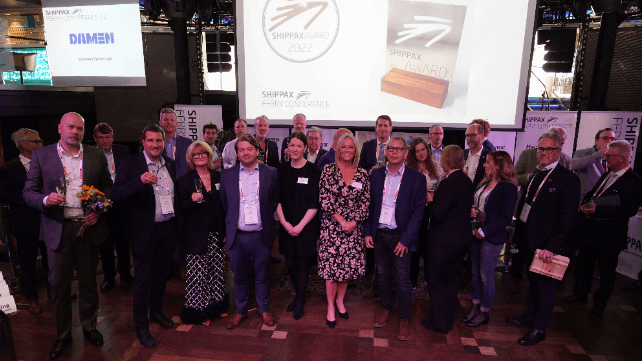
Published
May 16, 2022, 2:03 PM
The Maritime Executive
UECC has been recognised for its pioneering achievement in developing the world´s first multi-fuel LNG battery hybrid PCTC with the coveted Shippax Ro-Ro Technology & Environment Award for the Auto Advance.
This is a highly coveted trade award in the combined Ro/Ro, ferry and cruise industries. It was presented at the Shippax Ferry Conference, Silja Symphony, attended to by over 220 companies from this industry.
In the citation for the award, the Auto Advance was hailed as “a big step forward in eco-friendly Ro-Ro operations and at the same time an extremely flexible vessel conceived to be run on other, newly invented fuels in the future”.
“Her battery element contributes to reduce emissions even more than when only running on LNG, an approach which has every potential to be used for other Ro-Ro newbuildings as well,” it stated.
´Proactive investment´
The Shippax Awards are presented each year since 1996 to recognize innovation and notable design features in newly delivered newbuilds. All contenders are subject to careful scrutiny by an impartial panel.
UECC took the award in the pure car and truck carrier (PCTC) category together with China´s Jiangnan Shipyard and the latter´s in-house ship designer Shanghai Merchant Ship Design & Research Institute that collaborated to develop the unique vessel concept.
“We are delighted to receive this award in recognition of the efforts by Jiangnan Shipyard and UECC to bring this innovative solution to fruition, even amid capacity challenges caused by a pandemic,” says UECC´s Director Sales & Marketing, Bjorn Svenningsen.
“This award is vindication of UECC´s proactive investment in developing new sustainable solutions using available technology that can have an immediate impact to achieve environmental goals, as well as reduce operational costs through improved fuel efficiency.”
New configuration
The Auto Advance, which was delivered to the yard in late 2013 is the first of three newbuild PCTCs that incorporate multi-fuel LNG and hybrid technology in a new configuration. This vessel segment is geared towards improving energy efficiency and environmental performance.
The car carrier measures 169 by 28 meters and can carry 3600 vehicles on 10 cargo decks. It is currently operating shortsea trade routes between Northern Europe and Spain, linking Spain to the North Sea and Baltic regions.
The second-generation LNG-fuelled vessel is equipped with a multi-fuel two-stroke main engine combined with an energy storage system (ESS), supplied by Finland’s WE Tech, employing a permanent magnet shaft generator from WE Tech and Corvus battery pack.
With a highly economical 16-knot service speed, the vessel “offers a much lower carbon footprint than previous generations” of PCTCs and fuel economy is aided by the hybrid propulsion system on the vessel, according to the award jury´s assessment.
Alternative fuel-ready
As these fuels become more readily available, the vessel will also be capable of running on biofuel, synthetic LNG, and bio-LNG.
The ESS allows peak shaving of the main engine and auxiliaries, which reduces fuel consumption and emissions. A smart energy management system can optimize power usage to match operations. The shaft generator can charge batteries while on the seas so they are fully charged upon arrival at port.
UECC says that the combination of LNG battery hybrid technology and an optimised hull design for better fuel economy will allow these newbuilds exceed the IMO requirement to reduce carbon intensity by 40% by 2030.
Emissions of carbon dioxide will be reduced by more than 25%, SOx and particulate matter by 90% and NOx by 85% from the use of LNG, while the newbuilds will also meet the IMO’s Tier 3 NOx emissions limitations for the North Sea and Baltic Sea.
The Maritime Executive is not endorsed by the products and services described in this release.



